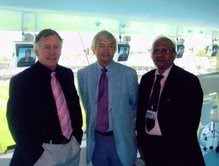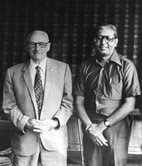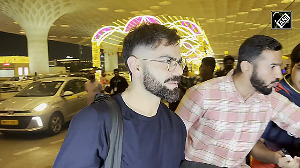Haresh Pandya pays tribute to noted radio commentator Suresh Saraiya, who passed away in Mumbai on Wednesday following a heart attack.
July 18, 2012, turned out to be a sad day for Hindi cinema and Indian cricket. For two stalwarts of the two different but inseparable fields (because Hindi films and cricket unite India) passed away that day. And both were the stars of the super 1970s in their own right. Indeed, if Rajesh Khanna was the heartthrob of the film buffs, Suresh Saraiya was the most loved cricket commentator in English.
A household name in the cricket-crazy India, Saraiya delighted the listeners of radio cricket commentary for well over four decades during which he broadcast over 100 Tests and 150 One-Day Internationals, including four World Cups, not forgetting a number of first-class games.
 As far as radio commentary in English was concerned, no one but Saraiya deserved the moniker, the Golden Voice of Indian Cricket, after the retirement of Anant Setalwad. He was one of the most natural and original of commentators. With his impressively articulate baritone, smooth delivery and distinct style, Saraiya commanded a large fan following across the country. Often he ran into strangers who identified him from his voice.
As far as radio commentary in English was concerned, no one but Saraiya deserved the moniker, the Golden Voice of Indian Cricket, after the retirement of Anant Setalwad. He was one of the most natural and original of commentators. With his impressively articulate baritone, smooth delivery and distinct style, Saraiya commanded a large fan following across the country. Often he ran into strangers who identified him from his voice.
"I humbly feel that cricket commentary is a God-given gift to me. I've always strove to be my natural, original self. I just hate to copy or imitate others. Of course, I still make conscious efforts to improve on every possible front. I think you can always strive harder and be still better than what you are," he told me a couple of years ago during a freewheeling conversation.
"Indian commentators in general are heavily patriotic flavoured. They're afraid of airing frank observations. They lack in humour and very laborious approach and bank on ackneyed phrases. Also, some have pompous approach with vanity of self voice being a major factor."
Saraiya was fairly methodical and meticulous when he donned the commentator's hat. He would double check correct pronunciations of the names of players and collected their necessary statistics and records. He gathered any information related to the players as well as umpires as he felt it came in handy when describing the proceedings.
"I seriously study the ground's history, peculiarity, if any, and other human-related information. I always try to introduce new words in every new season. I read and discuss current topics and other interesting news. It helps make atmosphere more interesting sometimes when you're on the mike," he said. "I always try to be a thorough team-man, consciously practising from the pinching time of my fellow commentators in the box. My choice is friendly, responsible and floating style preferred with sincerity and honesty."
The late John Arlott always remained Saraiya's "all-time favourite" radio broadcaster. And his "most favourite" in style, language, presentation and analytical mastery was Richie Benaud, who "stole" his "heart and head". The other radio and television broadcasters Saraiya admired included Alan McGilvray, Tony Cozier, Christopher Martin-Jenkins, Henry Blofeld, Charles Fortune, Gerald de Kok, Alan Marks, Bryan Waddle, Devraj Puri, Setalwad and, of course, Harsha Bhogle.
Besides Benaud, some of the other former cricketers-turned-commentators Saraiya had high regard for were Sunil Gavaskar, Ravi Shastri, Ian Chappell, Tony Greig, Tony Lewis, David Gower, Nasser Hussain, Martin Crowe and Ian Bishop. These men "reigned over" Saraiya's "sensitivity and sensibilities" at all times.
Saraiya found Gavaskar's commentary "shrewd and substance-oriented" and the "fearless and aggressive" Shastri's "cracking, commandeering and fascinatingly flavoured." He described Bhogle's approach as "upfront" and his style as "inimitable".
"Being in the same field, I salute all these magicians, who always display dignified direction of fineness of every action without overbearing opinions. Their views have always been rational. The romance of their descriptions will rule over your heart," he said of the broadcasters who made a lasting impression on his mind and heart.
 "I've enjoyed and cherished my experience of sharing the mike with the likes of Setalwad, Cozier, Blofeld, Allan Richards, McGilvray, Eric Gowder and Bhogle in English; and with Sushil Doshi, Skand Gupt, Vineet Garg, Murali Manohar Manjul and Ravi Chaturvedi in Hindi. These partners have had their own special styles and impressive personalities as well as the ability to create the atmosphere with wisdom and wavelength of sound knowledge."
"I've enjoyed and cherished my experience of sharing the mike with the likes of Setalwad, Cozier, Blofeld, Allan Richards, McGilvray, Eric Gowder and Bhogle in English; and with Sushil Doshi, Skand Gupt, Vineet Garg, Murali Manohar Manjul and Ravi Chaturvedi in Hindi. These partners have had their own special styles and impressive personalities as well as the ability to create the atmosphere with wisdom and wavelength of sound knowledge."
How did he find the ageless Cozier? "Cozier and I shared the mike in 3 of the 5 Tests of the 1974-75 home series against the West Indies; and unknowingly I fell in love with his amazing style, fluency and observations." And what about Blofeld? "I rate him very highly, but I place Martin-Jenkins above him because of his very smooth and warm style like Cozier's. Blofeld is a nice fellow but tends to be flippant at times. I like Blofeld the commentator, but can't stand his sight looks like a mad and desperate professor or sex maniac!"
Suresh Purushottamdas Saraiya was born on June 20, 1936, in Mumbai. His father, Purushottamdas, was a "non-corrupt, well-read and literary-inclined" station master in Western Railways and his mother, Kusumben, was a housewife. "My father believed in punctuality, honesty and hard work. Being a matriculate of the early twentieth century, he was very powerful in English as well as Gujarati literature. He was a staunch supporter of the Congress and an avid follower of Mahatma Gandhi, Jawaharlal Nehru and Vallabhbhai Patel," he proudly said.
A brilliant student, Saraiya did his B.A. in Economics from Wilson College, took a diploma in Public Relations and Publicity from Bhavan's College of Journalism and studied up to 2nd L.L.B. in Siddharth Law College and captained its cricket team in 1960 and 1961. He was a good cricketer and played for his college as well as university teams and rubbed shoulders with the giants such as Dilip Sardesai, Ajit Wadekar, Farokh Engineer, Ramakant Desai and Raj Singh Dungarpur. He had opened the innings with Sardesai for Wilson College from 1954 to 1958.
However, when he "realised" his "limitations" of becoming a state or national level player, he began to concentrate more and more on his "childhood dream" of making a foray into the world of cricket commentary. As a 16-year-old schoolboy, Saraiya gave such a wonderful display of imaginary ball by ball cricket commentary at an NCC camp in Aurangabad in 1952 that it won him a gold medal. The token recognition fired his ambition and also gave him the much-needed encouragement.
"My entry into the radio world wasn't easy. Presence of stalwart commentators like Pearson Surita, Puri, Berry Sarbadhikari, V.M Chakrapani, Dicky Rutnagur, Michael Marshall and, of course, Vijay Merchant meant a fresher had hardly any chance," he admitted. "However, radio executives were quality programme-oriented. Their objective was programme-related and not personality-based. Higher-ups in radio didn't care a hoot for pressure tactics to induct mediocre calibre in the world of cricket commentary."
But Saraiya's natural talent and flair for radio cricket commentary were simply irresistible for the All India Radio (AIR) authorities. He gave his first ball by ball running commentary in first-class cricket on December 21, 1965 at Brabourne Stadium in Mumbai. The erudite, sophisticated Rutnagur was his fellow commentator while the legendary Merchant was an expert commentator. "These two giants of mike encouraged me a lot and nursed my debut innings. Though a newcomer, there're no sings of tensions or nervousness about me because of the care, love, respect and warmth with which they treated me," he said.
 The first Test between India and Australia in Mumbai, which commenced on November 4, 1969, was Saraiya's maiden as a commentator. Sharing the mike with him were Puri ("versatile broadcaster"), Saradindu Sanyal ("leading broadcaster") and Prem Narayan ("magnetic voice") with Madhav Mantri being the expert commentator.
The first Test between India and Australia in Mumbai, which commenced on November 4, 1969, was Saraiya's maiden as a commentator. Sharing the mike with him were Puri ("versatile broadcaster"), Saradindu Sanyal ("leading broadcaster") and Prem Narayan ("magnetic voice") with Madhav Mantri being the expert commentator.
"In my first 15-minute spell, India lost 3 valuable wickets of Sardesai, Engineer and Chandu Borde. India's score slumped from 39 for no loss to 42 for the loss of 3 wickets. Graham McKenzie, who consumed the trio and rocked the Indian batting line-up with his accurate and devastating fast-medium bowling before Mansur Ali Khan Pataudi and Ashok Mankad rescued the innings, silenced the 45000-odd spectators," he stated going down memory lane.
"While I was describing the events, Puri was all the time standing behind me to examine me thoroughly my temperament, my fluency, my knowledge and my ability to build the tempo and the tension which was obviously felt bye one and all."
After Saraiya finished his first spell, a highly impressed and pleased Puri patted him on the back and said: "You're as good as anyone of us. Never fear anyone. Always broadcast without any favour to anyone. You've a bright future. You're destined to have a very long and distinguished innings in the commentator's box."
These were prophetic words and, to use an oft-repeated cricket cliché, Saraiya literally did not look back since then. He received golden advice from Merchant, Dungarpur and several other reputed names in the field of radio cricket commentary during the initial stage of his foray in the broadcasting world.
Merchant told the young Saraiya: "Upcoming artists and professionals sometimes use unethical means to overthrow the established ones without realising that all it takes for people to notice you is honesty and hard work." Dungarpur, one of Saraiya's "godfathers", advised him to stick to description at length, to give scores fairly repetitivly and not to pose as an expert on the game but to be a team-man and enjoy describing the proceedings.
The master raconteur always preferred radio to television as he relished speaking. Since dignified, golden silence is the key on the idiot box, it is not surprising that the loquacious Saraiya did only 7 Tests and 4 ODIs for television.
"My style is more suited to radio and it's my personal preference as well. By and large the AIR deputes commentators for the overseas tours. Doordarshan, on the other hand, used to depute them to cover Pakistan tours only. On this count, too, I had opted for radio and religiously remained with it," he revealed.
"During the Reliance World Cup on the subcontinent in 1987, both the AIR and Doordarshan wanted specialists. The authorities didn't favour commentators switching over from radio to television and vice versa. Senior AIR and Doordarshan executives therefore preferred separate panels. You weren't encouraged to describe at length on television. Of course, in the last ten years or so, the television authorities across the world have been preferring as well as advocating chatty chaps with description of action encouraged to cater to the general demands of viewers."
How had been his experience working and dealing with the AIR authorities? "A mixed bag of joy and sorrow. Quality has been given preference by some open-minded executives while few have been visionless and missionless bureaucrats for whom the rule book holds greater importance," he asserted without mincing words.
"Quality commentators aren't found in every corner of the country. Commentators provide you countless hours of joy and jealousy has just no place in the hearts of genuine performers. Gradual growth and continuity of proven broadcasters provide joy of listening, thereby building up fantastic reputation for the AIR. Generally, the higher-ups don't fall to pressures of outsiders, but at times some mediocre commentators manage to oust thoroughbred broadcasters."
Saraiya was invited by Radio New Zealand to broadcast the 1976 series between the Kiwis and the Indians. It was the first part of actually what was a twin tour as the Indian team headed to the exotic Caribbean islands straight from New Zealand to play four Tests against the mighty West Indies led by Clive Lloyd. It was in the West Indies in 1976 that Saraiya had the "finest moment" of his broadcasting career when India defeated the hosts by six wickets after successfully chasing 400-plus runs in the fourth innings at Port of Spain in Trinidad.
As India neared the famous triumph, Saraiya and his colleague Chaturvedi apparently fought with each other in order to be on the air when the winning stroke was hit! But the "emotionally charged up" and "overwhelmed" Chaturvedi had the last laugh and he "sang" the "praiseworthy efforts" of Gavaskar, Gundappa Viswanath, Mohinder Amarnath and others from a "grand platform".
In Saraiya's own words, the "saddest moment" of his broadcasting career was that never ever did the AIR deput him to Australia to give commentary, though he had gone down under as a guest commentator on India's 1981 tour and shared the mike with McGilvray and others on Radio Australia.
In Saraiya's view, the "funniest moment" of his career was on the historic tour of South Africa in 1992-93 for what was dubbed as the Friendship Series featuring four Tests and seven ODIs. In the absence of a Hindi commentator, Saraiya and his colleague Bhogle (who in those days was a radio commentator) were "ordered" by the "high command" to describe fall of wickets and scores in the national language in all the Tests and ODIs. Not only that, Saraiya and Bhogle would take turns and even do the scoring!
The star commentator, who commentated on the game from across the globe and toured Australia, England, Bangladesh, Canada, New Zealand, Pakistan, Sharjah,
Singapore, Sri Lanka, South Africa, West Indies and Zimbabwe, was full of joie de vivre till his last breath.
He had compeered and conducted over 100 sports roundups and sports quiz programmes on radio and television. On occasions he acted as a special correspondent for the PTI and UNI and several Hindi and Gujarati dailies. He wrote four booklets on cricket and one on football in Gujarati. He wrote sports columns in several Gujarati newspapers and edited quite a few tour souvenirs.
The list of awards bestowed on Saraiya is a little longer. But the honour he cherished the most was his inclusion in the audio archives produced by Marylebone Cricket Club (MCC), featuring him as one of the "top most contributors" to Indian cricket in its 75 years.
It appeared as though Saraiya, who retired as the chief Public Relations Officer of Central Bank of India's central office in Mumbai after nearly 33 years, wanted to continue commentating on cricket for eternity. So passionate was he about cricket and broadcasting. "I plan to exit simultaneously with Sachin Ramesh Tendulkar whenever the Master Blaster calls it a day," he said, not lightly but very seriously.
Photographs: Haresh Pandya










